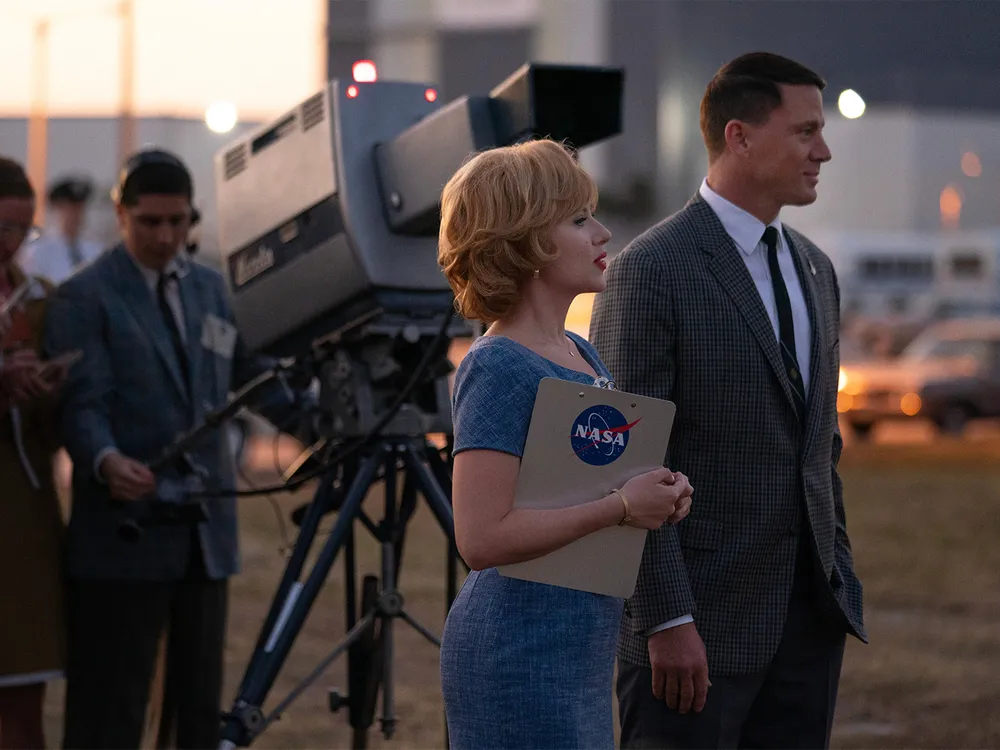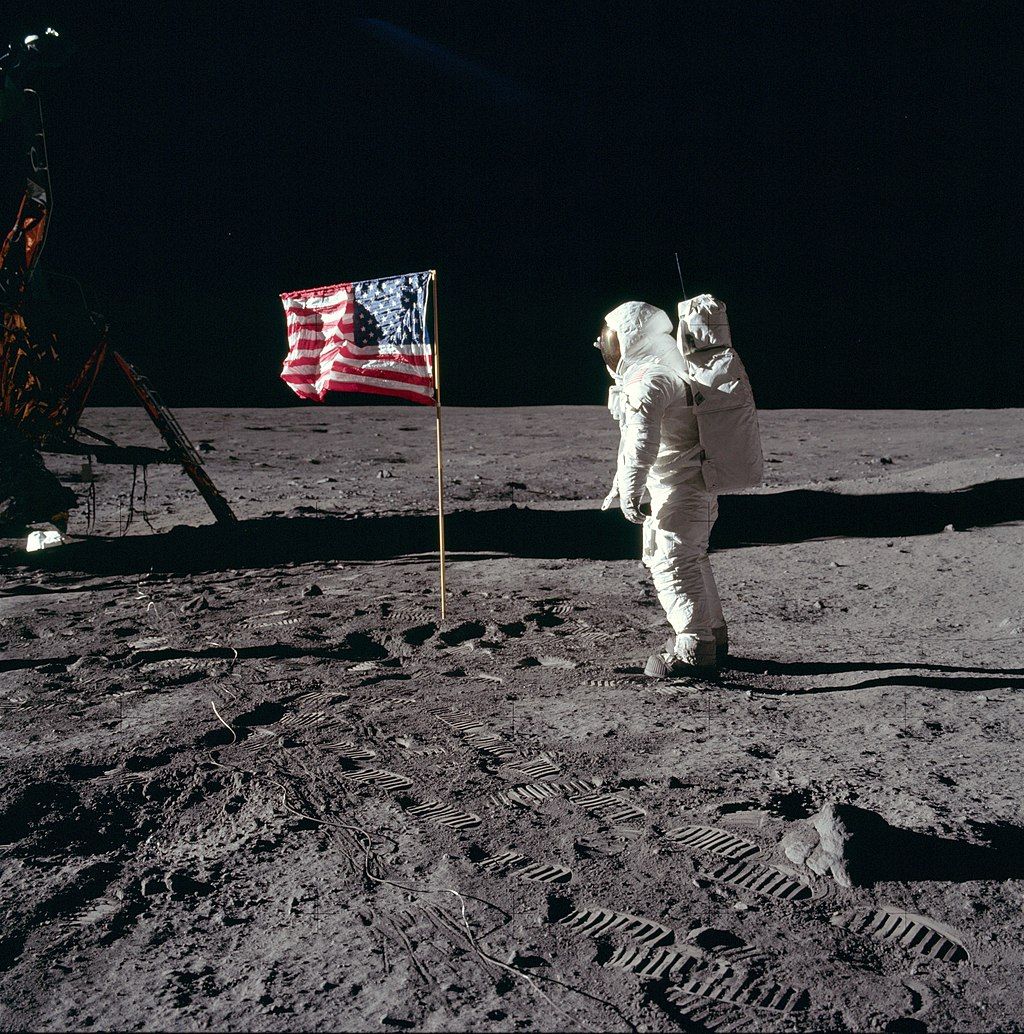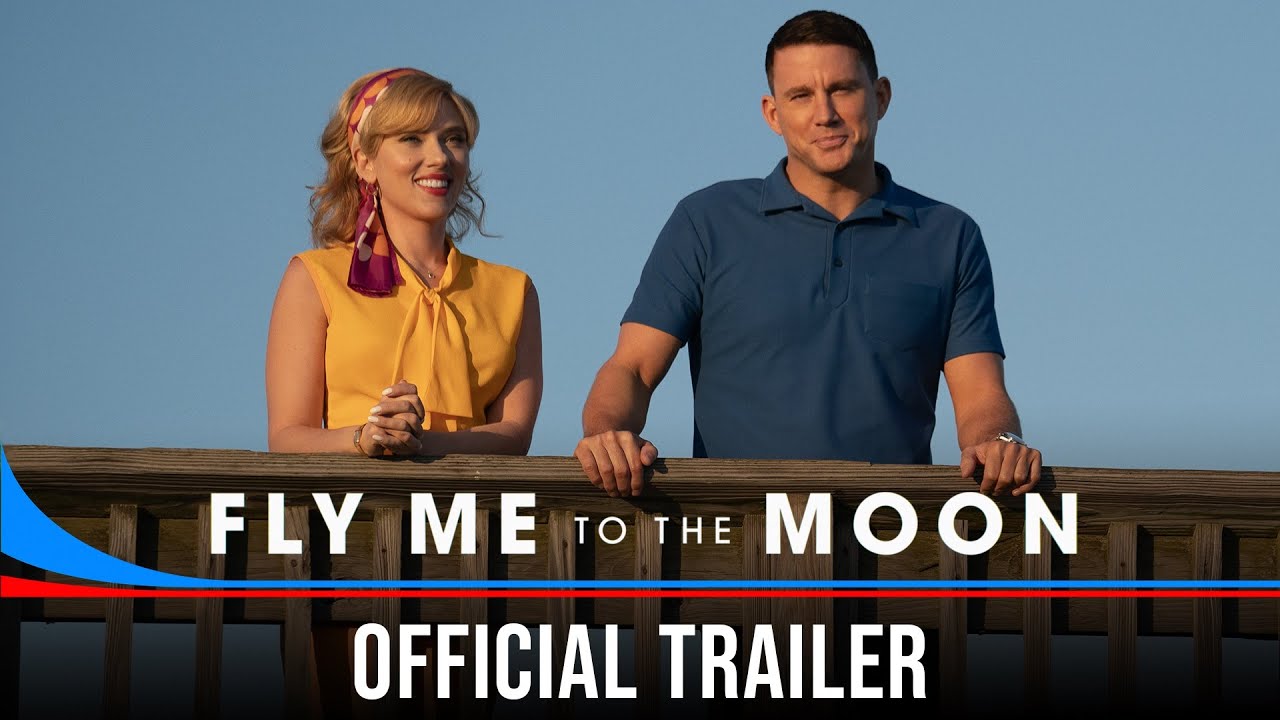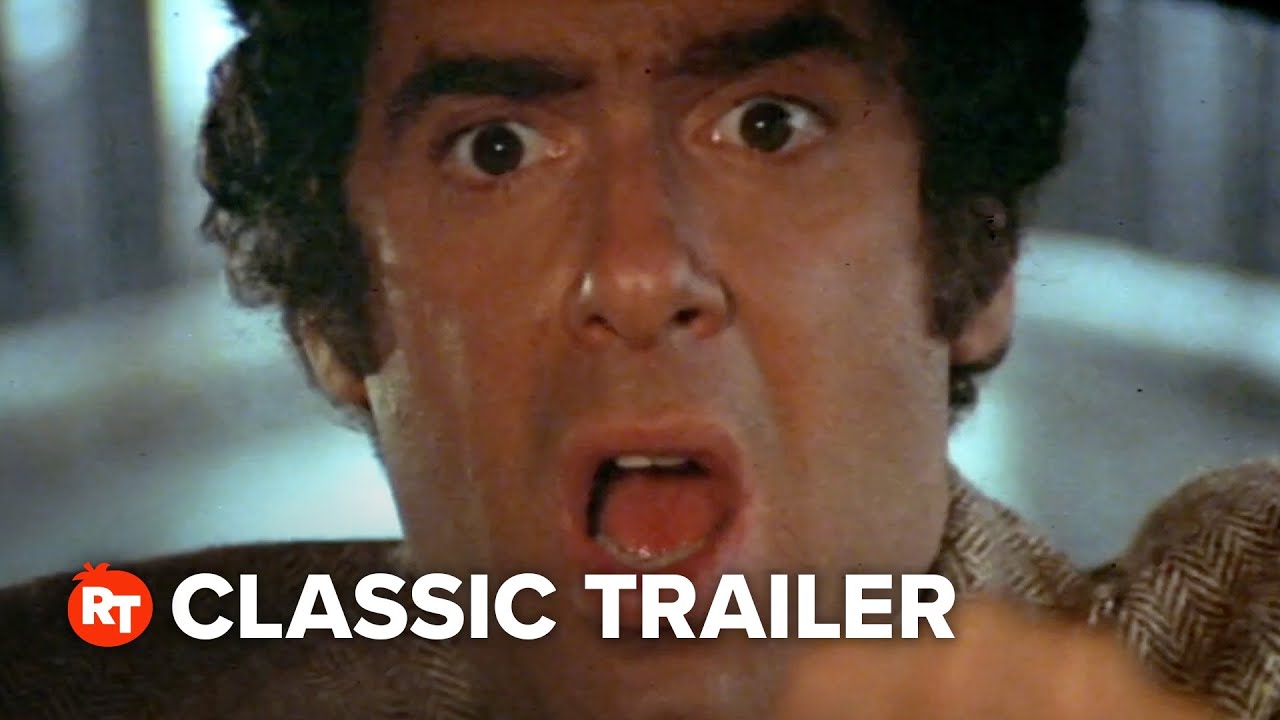How ‘Fly Me to the Moon’ Pokes Fun at Moon Landing Conspiracy Theories

Scarlett Johansson and Channing Tatum in Fly Me to the Moon, a new movie directed by Greg Berlanti
Apple TV+
Less than a decade after the July 20, 1969, moon landing united much of the world in astonishment and awe, various movies, books and other sources started claiming that the Apollo 11 mission was a massive hoax. Skeptics pointed to supposed “evidence”—misaligned shadows, the absence of visible stars behind Neil Armstrong’s helmeted head, the fact that the American flag was extended as though flapping in an impossible breeze (it was, in truth, supported by a horizontal rod)—to speculate that the published images from the lunar expedition had been fabricated.
The new romantic comedy Fly Me to the Moon trades on that thoroughly debunked but oft-repeated conspiracy theory. Arriving in theaters across the United States on July 12, the film, which stars Scarlett Johansson and Channing Tatum, doesn’t assert that the mission was a sham. Instead, it envisions in farcical fashion what would have happened if the government had a plan to fake the moon landing in case the real mission failed.
In the movie’s fanciful telling, NASA flight director Cole Davis (played by Tatum)—a fictional character inspired partly by real-life titleholders Gene Kranz and Gerry Griffin, the latter of whom served as an adviser on the production—is unaware of the conspiracy. He’s too busy trying to make the real mission work, not to mention too honorable to take part in such deception.
Johansson, meanwhile, portrays Kelly Jones, an advertising whiz who’s initially brought in to sell the Apollo program to a skeptical public. Exaggeration doesn’t bother her; nor does casting telegenic, cooperative actors to stand in for real NASA officials who are either too busy or too camera shy to take part in TV interviews. But Kelly gets pushed beyond her ethical boundaries when she finds herself blackmailed by a shadowy government operative (Woody Harrelson) who tasks her with organizing a film shoot simulating the moon landing.
“We should’ve gotten [Stanley] Kubrick,” Kelly sighs at one point in Fly Me to the Moon, alluding to the stubborn falsehood that the filmmaker, who released the landmark sci-fi film 2001: A Space Odyssey in April 1968, 15 months before Armstrong left the first boot print in the lunar dust, was commissioned to fabricate the footage of Apollo 11 on the moon.
Margaret A. Weitekamp, chair of the Space History Department at the Smithsonian’s National Air and Space Museum and the author of Space Craze: America’s Enduring Fascination With Real and Imagined Spaceflight, says these conspiracy theories reflect a view of government that grew more jaundiced as the various sociopolitical shocks of the 1960s piled up.
“You’ve got a real fracturing of trust in the general public that starts with things like the Gulf of Tonkin incident,” Weitekamp explains. “And that’s exacerbated by Watergate, by the Pentagon Papers, by all of these various revelations that the government was actually not just hiding things from people but actively lying to the American public. … And by the end of the Apollo program in 1972, there are good reasons, sometimes, not to trust what the federal government is saying.”
Buzz Aldrin salutes the deployed United States flag on the lunar surface.
The moon hoax movement got a big boost from the 1976 publication of We Never Went to the Moon: America’s Thirty Billion Dollar Swindle, a purported tell-all penned by Bill Kaysing, a former Naval officer who, until 1963, had worked for Rocketdyne, one of the contractors that helped build the Saturn V rocket. By that point, two years after the Watergate scandal forced President Richard M. Nixon to resign, America was experiencing what its next elected commander in chief, Jimmy Carter, would soon call a “crisis of confidence.”
Beyond the skepticism that the U.S. government provoked by mishandling unrelated affairs, the public had another motive to doubt Apollo’s achievements: Many Americans were never on board with the enormously expensive program, which sent 24 astronauts to the moon between 1968 and 1972, in the first place. “If you go back to the [1960s] public opinion polls, overall support for the Apollo program only gets to like 40 percent,” Weitekamp says. Yet “we tend to look back and think, ‘Oh, everybody was really united and super excited about this.’”
While Americans believed that humans were capable of reaching the moon, they questioned whether achieving this milestone was the right move. The question in many quarters was, according to Weitekamp, “How is it that we can do that, but we can’t [address] inner city schools, or public health care, or racism, or urban blight?”
Even before the cancellation of the final three planned missions of the Apollo program, that skepticism had embedded itself in popular culture. The 1971 James Bond film Diamonds Are Forever, released a year before Apollo 17 became America’s final crewed lunar expedition of the 20th century, contains a gag in which 007, having infiltrated a supervillain’s Las Vegas hideout, crashes into a stage where actors in spacesuits are pretending to walk in lunar gravity. He steals their moon buggy to make his escape.
Evidently, NASA had no objection to director Greg Berlanti, screenwriter Rose Gilroy and their collaborators making liberal use of their artistic license in Fly Me to the Moon. The space agency lent its support to the production, much as it did with the British-financed 1977 film Capricorn One, despite that movie’s depiction of the agency’s leadership in a far more sinister light than anything posited by Fly Me to the Moon.
A conspiracy thriller directed by Peter Hyams, Capricorn One imagines NASA’s first crewed mission to Mars. Faced with declining public interest and the revelation that the spacecraft’s life-support system will fail en route, NASA chooses to pull the three-man crew from the vessel just moments before launch. The uncrewed rocket blasts off for the Red Planet as scheduled, and the three astronauts are sequestered in secret during the months they’re supposedly flying to and from Mars.
Later, the trio is coerced into participating in a phony Mars landing, televised from a soundstage on an isolated base. The plan is for these reluctant actors to be welcomed home as conquering heroes once their spacecraft returns to Earth. But when the craft’s command module burns up upon re-entry, the astronauts become hunted men—living proof of a scheme to hoodwink the American people.
Even the impulse to try to debunk NASA is a reflection of the agency’s significance, says Brian Odom, NASA’s chief historian. “What’s so sexy about conspiracy theories is [the idea that] not only do I know the truth about something that other people don’t know, I know something when it comes to NASA and science and space exploration,” he says. “I know a truth about the ‘most intellectual’ of all human engagement.”
According to Odom, NASA wasn’t quite as desperate to promote itself during the Apollo era as Fly Me to the Moon suggests.
“NASA had a really healthy public affairs program in the 1960s, but their job wasn’t necessarily or totally to sell the benefits of the space program or to convince people this investment was worthwhile,” he says. “It really was to communicate transparently what the work of the agency was—to be there at launches and to project those to the country and to the world.”
Odom cites NASA public affairs officer Julian Scheer, who left the agency when the Apollo program ended, as being largely responsible for shaping America’s perception of its lunar explorers. As Armstrong, the first man on the moon, once said, “[Scheer] understood the needs of the media and also the needs of the flight crews. He was, in many cases, able to accommodate both.”
Omega Speedmaster ad, 1976
“How can a man in a $27,000 suit settle for a $235 watch?”
Iconic use of price anchoring and social proof. pic.twitter.com/fDEJBmwmrh
— The Ad Professor (@The_AdProfessor) May 28, 2023
Fly Me to the Moon also gently satirizes the way astronauts were drafted as de facto pitchmen for products like Tang drink mix and Hasselblad cameras. In actuality, Odom characterizes the agency’s interactions with the various manufacturers that were lining up to give their products some of that space race sheen as “more reactive than proactive.” Companies like Omega, a Swiss luxury watchmaker, wanted “to promote the idea that their product is associated with the space program,” Odom says. “And so there was some mutual benefit.”
The appearance of a cozy relationship between Madison Avenue and Mission Control is the kind of thing conspiracy buffs seize upon, too. But, ultimately, it isn’t NASA’s job to try to win over those who just won’t accept the truth.
“There’s no arguing with someone who refuses to see the value of credible evidence,” Odom says.
Channing Tatum (left) and Ray Romano (right) in Fly Me to the Moon
While Fly Me to the Moon chugs along on Johansson and Tatum’s chemistry, it’s a more awkward blend of fact and fantasy than, for example, the Apple TV+ series “For All Mankind,” an alternate history of the space race that imagines what might have happened if the Soviet Union landed on the moon before the U.S. did. In this fictional world, the American space program continues to operate at Apollo-era levels of urgency well into the 21st century, resulting in permanent commercial colonies on both the moon and Mars.
While that kind of ongoing brinkmanship might have accelerated human colonization of space, Odom says Americans should be grateful it didn’t actually happen. Whereas Apollo was driven by a desire to beat the Soviets, Artemis, NASA’s 21st-century lunar exploration initiative, is unfolding in a less openly hostile environment as it seeks to establish a permanent base on the moon to facilitate human missions to Mars.
As the historian says, “The most fundamental difference between Artemis and Apollo really is this idea that [Artemis] is not done on the basis of countering an existential threat,” in this case the might of the Soviet Union. Odom adds, “This is human space exploration at its finest, which is collaborative and open.”





